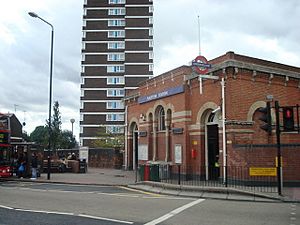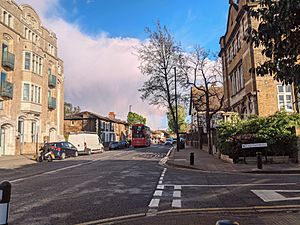Plaistow, Newham facts for kids
Quick facts for kids Plaistow |
|
|---|---|
 Plaistow Underground station |
|
 Greengate Street, Plaistow |
|
| Population | 31,874 (2011 Census. Plaistow North and South Wards) |
| OS grid reference | TQ405825 |
| London borough | |
| Ceremonial county | Greater London |
| Region | |
| Country | England |
| Sovereign state | United Kingdom |
| Post town | LONDON |
| Postcode district | E13 |
| Dialling code | 020 |
| Police | Metropolitan |
| Fire | London |
| Ambulance | London |
| EU Parliament | London |
| UK Parliament |
|
| London Assembly | |
Plaistow is a lively area in East London, England. It is part of the London Borough of Newham. Plaistow is surrounded by other areas like Upton Park, East Ham, Beckton, Canning Town, and West Ham.
Long ago, Plaistow was a small part of a larger area called West Ham, in the historic county of Essex. Since 1965, it has been part of the London Borough of Newham. This borough is a local government district within Greater London. Most of Plaistow is covered by the London E13 postcode.
Main roads in Plaistow include the A112 (Prince Regent Lane, Greengate Street, The Broadway, High Street, and Plaistow Road). Plaistow Road used to be an old Roman road. The A124 (Barking Road) also runs through Plaistow. You can find shops and businesses along the A112 and A124.
Contents
What's in a Name?
The name Plaistow has a few interesting ideas about where it came from.
Some people think it comes from Sir Hugh de Plaiz. He married Philippa de Montfitchet in 1065. Her family owned the land, and she might have named it the Manor of Plaiz.
However, other experts suggest the name comes from Old English words. Pleg means 'sport' or 'playing', and stowe means 'place'. So, Plaistow might have been a 'playing place'. This is because miracle plays (old religious plays) were performed here. This idea is supported by how the name appeared in old records, like "Plagestoue" around 1200 and "Playstowe" in 1414.
Another idea is that Plaistow was the 'Stow' (or village) of the de Plaiz family. This links back to Sir Hugh de Plaiz.
A Look Back in Time
Early History
One of Plaistow's oldest roads is Balaam Street. It might be named after Hugh de Balun, who owned land here in the 1100s.
In 1353, the manor of Plaistow was given to a religious house called Stratford Langthorne Abbey. Later, when these abbeys were closed down by the King, the land became Crown property. It was then given to Sir Roger Cholmeley in 1553.
The 1700s
In 1724, writer Daniel Defoe mentioned Plaistow in his book. He said many new buildings had been built there. Plaistow is also linked to the famous highwayman Dick Turpin. Stories say he stole from a Mr Giles in Plaistow in 1730.
Even in the 1700s, Plaistow was a quiet, country village. It was considered a day's coach journey from Westminster, even though it's only about 8 miles away. The Black Lion pub on High Street is a very old landmark, possibly dating back to 1742.
The 1800s
In 1844, John Curwen opened the Plaistow Public School. That same year, Plaistow became its own Anglican parish. Its church, St Mary's, became the main church for the new parish. John Curwen also started a printing business in Plaistow in 1863.
By the 1870s, Plaistow was changing from a farming area to one with more factories. The population grew, reaching over 11,000 by 1861. In 1886, Plaistow became part of the new County Borough of West Ham.
Many new churches were built in Plaistow in the late 1800s. Only two, St Martin's and St Andrew's, are still standing today.
The 1900s to Today
Plaistow got telephone service in 1905. It even had its own Member of Parliament (MP) from 1918 to 1950.
The Memorial Baptist Church was built in 1921 to remember those who died in the First World War. It's now a historic building. Its ten bells have the names of over 150 men who died, which is the most names on any set of bells in the world!
In 1921, the YMCA opened Greengate House. This building was once used as an Art college by the University of East London. The front of the building was kept and modernised, and new flats were built behind it.
Plaistow was badly damaged during the Second World War bombings. Many homes were destroyed. In the 1960s, new council housing estates were built on these damaged sites. The Black Lion pub was a popular spot for West Ham United football players like Bobby Moore in the 1960s and 70s.
In 1965, Plaistow became part of the new London Borough of Newham. This happened when West Ham joined with East Ham and other small areas.
Towards the end of the 1990s, a big project started to improve Plaistow. This project aimed to create jobs, build new homes, and make the area better for everyone. In 2012, Plaistow South received £1 million to fund local projects. New homes were also built on the site of the old Plaistow Hospital starting in 2013.
Fun Things to Do
Plaistow has some great green spaces. Plaistow Park is about 9.5 acres, and Memorial Park is 10 acres. Memorial Park connects to the East London Cemetery. There are also smaller parks, and the large West Ham Park is about 1 mile north.
You can also find Newham Leisure Centre and Balaam Street Leisure Centre here. Newham University Hospital is in Plaistow, as is the main campus of Newham Sixth Form College.
The Terence McMillan Stadium is in Plaistow. It's named after the first mayor of Newham. This stadium is home to local football teams like Athletic Newham and Fire United Christian. It's also part of the Newham Leisure Centre. The West Ham Boys' Amateur Boxing Club is located behind the Black Lion pub.
The 59 Club, a motorcycle club that helps people, is based in Plaistow.
Learning in Plaistow
Plaistow has excellent schools. Nathan Kemp, an assistant headteacher at Tollgate Primary School, won the national Teacher of the Year award in 2012. Another teacher from Tollgate, Michael Patient, won a silver award for outstanding new teacher in 2014.
Plaistow in Pop Culture
The music video for "(Keep Feeling) Fascination" by the Human League was filmed in Plaistow. It featured a house painted completely orange!
Famous Faces from Plaistow
Many talented people have come from Plaistow:
- Writers and Artists: Aaron Hill, a writer, lived here. William Holl the Younger, a famous engraver, was born in Plaistow.
- Musicians: Singers David Essex, Ronnie Lane, Jade Ewen, and Mumzy Stranger were born here. Comedian and folk singer Richard Digance is also from Plaistow. Rapper 21 Savage was born here before moving to the United States.
- Actors: Actors Terence Stamp, Honor Blackman, Jimmy Akingbola, and Roberta Taylor were born in Plaistow.
- Sports Stars: Olympic athlete Fred Alsop was born here. England international footballers Sol Campbell, Tony Cottee, Rob Lee, and Martin Peters are from Plaistow. Edward Temme, who was the first person to swim the English Channel in both directions, was also born here.
- Other Notable People: Luke Howard, who created the system for naming clouds, lived and worked in Plaistow. Sir David Amess, a Member of Parliament, was born in Plaistow.
Getting Around Plaistow
Trains and Tubes
Plaistow and Upton Park tube stations are in the area. They are on the London Underground District and Hammersmith & City lines. These lines connect Plaistow to places like the City, King's Cross, and Westminster.
West Ham station is also close by. It has the Jubilee line and Docklands Light Railway (DLR). These connect to Stratford International, London City Airport, and London Bridge.
Since 2022, you can also get to London Heathrow Airport from the nearby Custom House station using the Elizabeth line.
Buses
Plaistow is well-served by London Buses. Many routes run through the area, including routes 5, 69, 115, 147, 241, 262, 276, 300, 325, 330, 473, 678, and the night bus N15.
Cycling
The Greenway is a path for walking and cycling that goes through Plaistow. It connects to the Queen Elizabeth Olympic Park and goes towards East Ham and Beckton. It's part of London's cycle network.
Cycle Superhighway 2 (CS2) runs near Plaistow, through Stratford. It offers a mostly traffic-free route towards the City of London. Cycle Superhighway 3 (CS3) runs along the south of Plaistow. It also offers a mostly traffic-free route towards the City and even further to Hyde Park and Buckingham Palace.
Roads
Major roads connect Plaistow to other parts of London:
- A112 (High Street, Greengate Street, Prince Regent Lane): Goes south to London City Airport and north to Stratford.
- A124 (Barking Road): Goes south-west to Canning Town and north-east towards East Ham and Barking.
- The A13 runs along the very south of Plaistow. It connects to the City of London in the west and Barking and Southend-on-Sea in the east.
Nearby Places
- Canning Town
- Custom House
- East Ham
- Forest Gate
- Stratford
- Upton Park
- West Ham



